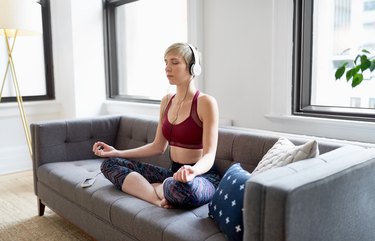
When you think meditation, you probably imagine sitting quietly while deep breathing. While that's a valid practice, it's far from your only option.
If sitting still isn't for you, a body-centered technique may be the mindfulness hack you've been looking for. Enter walking meditation.
Video of the Day
Video of the Day
LIVESTRONG.COM talked to Marlena Lambert, LMT, a somatic educator, as well as Ash Wix, a yoga teacher and founder of Out Together, to learn all about walking meditations and how to do them.
What Is Walking Meditation?
"It's good to start with what meditation is, and that is a certain quality of skillful awareness," Lambert says. "Walking meditation, then, is not just taking a walk in your neighborhood. It's an intentional practice."
Building awareness of your body and the world around you is an important aspect of doing a walking meditation, but it's not the only purpose of the practice.
"A walking meditation for me is when I take the time and attention to be intentional," Wix says. "It doesn't matter how long or short the walk is, as long as I'm intentionally engaging in my breath and senses as I go."
In other words, a walking meditation can be what you want it to be. You may prefer to focus on your footfall as you walk, or perhaps it feels better to observe the sights and sounds around you as you stroll (more on all of that in a moment).
Whatever your focus, though, the goal is to ground yourself in the moment.
How to Do a Walking Meditation
Here are Lambert and Wix's tips for how to try meditation while walking. You can use this as a step-by-step guide, or you can mix and match their suggestions to craft your own walking meditation.
1. Do a Body Scan
Lambert says a good way to kick off your walk is to focus your attention on your body.
"I start with a standing body scan," Lambert says. "The awareness of posture, the awareness of connection of feet to ground — it starts with that awareness of the body and standing. Then I shift weight from front to back, heel to toe, side to side, one foot to the other."
2. Focus on Each Movement
From there, you can turn your attention to your movements.
Being aware of your body during a walking meditation is a very different experience than taking a walk, Lambert says. Rather than going into autopilot and letting your legs do their thing, a walking meditation involves attention to the details.
"Take slow, intentional steps, feeling the movement in each part of your body as you lift your foot and shift your balance onto the other," Wix says. "Feel the ground on the sole of your foot and the texture and temperature of the earth beneath you."
3. Try Breathing Exercises
Once you get the hang of the movement, you can tie it to your breathing practice.
"You can bring in a breathing meditation like [inhaling] for one foot and [exhaling] for the other," Lambert says.
4. Tune in to Your Senses
You might find it hard to turn off the chatter in your brain — and that's normal.
Wix has some tips to help you quiet that voice and focus on your walk: "Start by intentionally committing to letting any thoughts that come through your head pass by for the duration of the walk," Wix says. "Focus on one sense at a time: Look around you, taking in the whole landscape and letting your vision go soft."
Once you've observed the scenery, you may want to close your eyes and listen to the sounds around you, "including those that seem disruptive — yelling children and loud cars are just as much part of the experience as wind and bird song," Wix says.
Next, pay attention to what you can smell so that each of your senses is engaged.
5. Take It Slow
The point of doing a walking meditation is not how fast you can do it — it's to keep your awareness in the present and away from the past or future.
The best way to do this? "Go as slowly as you can at first until you are able to take in all these senses at once," Wix says. "Keep breathing. Keep practicing. Once you have that flow, you can bring that practice to any activity any time you need a break from distracting thoughts."
Tip
There's no one best time to meditate. Instead, find a time that works well for you and then stick to it to build a consistent daily practice.
Benefits of Walking Meditation
Doing a walking meditation is just as valid as any other mindfulness practice. And according to the Mayo Clinic, making a regular habit of mindful walking or other meditation techniques may benefit your health in the following ways:
- Ease and prevent stress
- Increase self-awareness
- Reduce negative emotions
- Improve imagination and creativity
- Lower your resting heart rate and blood pressure
- Improve your sleep
And besides these health benefits of meditation, a walking meditation in particular offers the following perks:
1. It Can Ground You in Your Body
For Lambert, the core of walking meditation is the body-centered awareness that comes from taking steps.
"Walking is something we can take for granted: We don't think about it, but [many of us] know how to do it," Lambert says.
And slowing down to pay attention to the nuances of every aspect of a footfall can lend a new awareness to your physicality.
Movement may also be an effective way to get out of your head. Wix says the point of meditation "is not to stop yourself thinking altogether, but just to be more aware of those thoughts and not feel pulled around by them. Let those thoughts come and go, stop identifying with them and be present with the senses."
"For some people, that's easier to accomplish by sitting still and tuning in to breath. For others, it's easier to find that flow in a state of motion or stimulation," Wix says.
2. It May Be More Accessible for Some
Meditations that involve stillness can be intimidating — after all, it's hard to focus your mind in the present moment. Walking may better facilitate that mindfulness by making movement the object of your attention, Lambert says.
Was this article helpful?
150 Characters Max
0/150
Thank you for sharing!
Thank you for your feedback!
Is this an emergency? If you are experiencing serious medical symptoms, please see the National Library of Medicine’s list of signs you need emergency medical attention or call 911.


